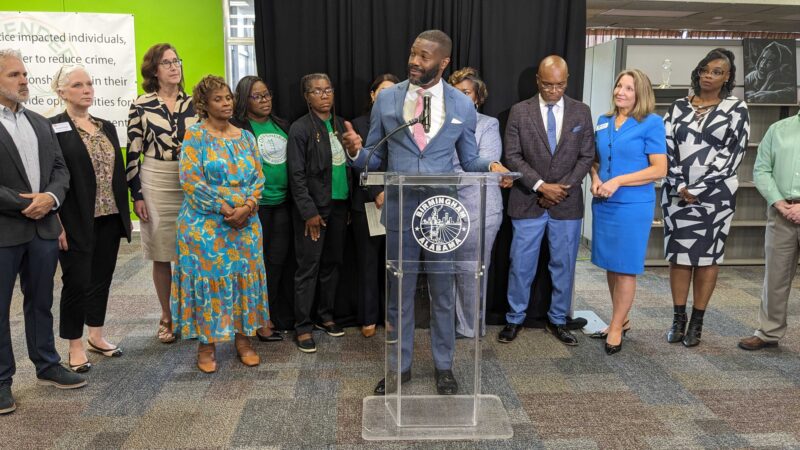Food Safety
“I eat ground turkey. I make ground turkey balls, turkey meat loaf. I even tried making a turkey hamburger the other day! (laughs) because I missed eating hamburgers.”
Teat and many of her friends in McCalla, Alabama, stopped eating beef after Teat’s husband – Jim – died three years ago. His autopsy blamed a subdermal hematoma, but Teat swears Jim died of Creutzfeldt-Jakob Disease – or CJD… the human version of Mad Cow disease. He was an active 74 year old who loved to garden and exercise on his rowing machine when he fell ill.
“He kept falling and his arm kept jerking and we were eating lunch, it was on a Saturday, and his arm just started jerking every second and his face fell over in his plate.”
Eight months after the first symptoms appeared, Jim Teat was dead.
The U.S. government says the risk of contracting CJD is very small. The Centers for Disease Control reports just one CJD death per million population each year – and certain forms of CJD may occur naturally in older people. A variant of Creutzfeldt-Jakob, which researchers suspect may be caused by eating meat from infected cows, has killed 153 people, mostly in Britain. But the recent discovery of an infected cow in Washington State has focused a lot of attention on the U.S. beef industry.
In Trussville, Alabama – rancher Richard Beard tends to his herd of 300 cattle. He’s been in the cattle business more than 50 years. The past few years he’s raised all-natural beef – no antibiotics or hormones.
“As far as I’m concerned, American beef – regardless of whether it came from this farm or some farm in Texas or Kansas, it’s all safe because it’s been raised under safe conditions.”
Safe conditions including a 1997 USDA ruling that banned feeding animal by-products to cattle. Mad cow – also known as bovine spongiform encephalopathy or BSE – is spread by animal feed contaminated by brain and spinal tissue from infected cows. The Washington State cow that tested positive ate contaminated feed before Canada and the U-S enacted the ban. Nearly any beef you’d buy at the supermarket now would have been born after the ban.
Just up the road from Beard’s ranch, large animal veterinarian David Evans inspects cattle getting ready for auction at the Asheville Stockyard. Evans says the threat of mad cow infection in humans has been blown out of proportion. It’s a legitimate concern for the cattle industry from an economic standpoint – one outbreak and beef sales drop and the export market dries up – but, Evan says, a new cattle tracking system that’ll be mandatory starting this fall should help put those fears to rest.
“We’ll be able to identify the animals from birth to the feed lot and consumers will know where they came from and what country or origin they originated in.”
“Mad cow is glamorous. It gets a lot of press.”
Jay Franks is president of SafetyCheck America – a Chicago-based consulting firm that helps food companies comply with federal regulations.
“The real risks are everyday salmonella, e-coli, listeria, the things that our company deals with on a day-in, day-our basis.”
The science backs him up on that. Each year in the U.S. 50 people die of campylobacter – a bacteria spread through contaminated poultry and unpasteurized milk. 60 die from e-coli. Listeria kills 500 Americans annually and Salmonella? 600 deaths each year in the U.S.
In the food safety lab at Auburn University – researchers are working on technology that may one day protect consumers from these and other potentially deadly foodbourne illnesses.
There’s a machine here called the stomacher. It’s about the size of a bread box, with two paddles that beat on a plastic bag filled with a water-like buffer and 25 grams of a meat sample. Once the meat is mixed into the buffer the sample is tested for e-coli, salmonella and other contaminants. Dr. Jean Weese and her colleagues are also working on a microchip that could be implanted in the soaker pad at the bottom of a meat package to detect bacteria.
“And then when you scan it over the scanner at the grocery store an alarm light would go off – this has bacteria – don’t sell it!”
Weese imagines a day when consumers could have their own hand-held scanners at home to check meat for contamination. It would increase food safety, she says – but at what cost?
“The only people that are buying into it are the chip people because they can see ‘wow, every package of chicken, this is dollars! Cha-ching!’ you know. But the food industry is saying, ‘Wait a minute! We’re not going to be able to sell any product! This is going to be a disaster for us!’”
Weese worries that increased pressure from government regulators and consumers for food that’s 100% percent safe will mean that eventually, consumers won’t be able to buy raw product in the grocery store. Everything – including fruits and vegetables, which can harbor e-coli and other bacteria – will be pre-cooked, pre-packaged… and probably more expensive!
Will shoppers go for it? Reaction is mixed at the Piggly Wiggly Grocery Store in Homewood. Aubrey Henderson says she already takes enough precautions at home – she’s not worried about the safety of her food.
“I wash my fruit before I use it – apples and lemons and oranges, things like that. I clean my vegetables real good.”
June Farrell also washes her fruits and veggies and takes care to cook her meat thoroughly, but still – she worries. And so does shopper Truman Parrott.
(Farrell) “Well some of this stuff they’re putting in the cows I don’t agree with anymore. Even these chickens – I was just reading to see what was in them.”
(Parrott) “When it’s on the television and it first comes out and everything it’ll kind of worry you and you’ll think about it awhile, but after a while you have to go back to living and you just have to eat something and hope that it won’t kill you.”
Americans love food – it’s a pillar of our economy, it even has its own cable TV channel. But we get really anxious when we think that our food could hurt us – make us sick, make us fat, or even kill us. So, we’re bound to continue the public dialogue about the pleasures and perils of our breakfast, lunch and dinner.

— causes more than 2 million infections annually in the U.S.
— approx. 50 deaths annually
— from contaminated chicken and unpasteurized milk
— may be drug resistant

— nearly 1.4 million cases of illness annually
— estimated to cause 600 deaths each year in the U.S.
— from contaminated beef, poulty, pork and eggs. Experts say more than half of all chicken on grocery store shelves may contain salmonella.
— may be multi-drug resistant

— approx. 73,000 cases annually in the U.S.
— more than 60 deaths each year
— acquired primarily through ground beef, but can be present on lettuce, unpasteurized milk and juice, and contaminated water.

— only a problem when transferred from the intestines (where it is common) to other parts of the body
— causes 10,000 urinary tract, 25,000 systemic blood, 40,000 wound, and 1,100 heart valve infections each year in the U.S.

— nearly 500,000 annually in the U.S.
— about 3% of people infected with one kind of Shigella will later develop Reiter’s Syndrome, which can lead to chronic arthritis
— acquired by consuming contaminated food or water or swimming in water contaminated with human or animal waste

— 2,500 cases annually in the U.S.
— 500 deaths each year, mostly pregnant women, newborn children and people with weakened immune systems
— responds to antibiotics, if administered promptly
— Listeria food poisoning is mainly a problem with ready-to-eat foods
Gambling bill in doubt with three days left in the legislative session
Alabama lawmakers are coming down to the finish line for this year’s legislative session. Many bills await passage, but perhaps the biggest one up in the air is a lottery and gambling bill.
Pro-Palestinian demonstration draws counter-protest at University of Alabama
Students gathered demanding the school call for a permanent and immediate ceasefire and to push the school to sever ties with defense contractor Lockheed Martin.
A new Statehouse and related projects will cost about $400 million
The Alabama Legislative Council, a 20-member panel comprised of legislative leaders and their appointees, approved the construction of the new Statehouse last year. The panel was given an update on the project on Wednesday.
New pilot program will offer housing, resources to people leaving prison
The Birmingham Reentry Alliance will provide wrap around services to dozens of men and women adjusting to life after prison.
Alabama committee advances ban on LGBTQ+ pride flags in classrooms
The Senate Education Policy Committee voted 5-2 for the House-passed bill, putting the proposal in line for a possible final passage in the last four days of the legislative session.
A New Orleans garden paid hundreds of dollars in fees for a sewer that doesn’t exist
Galvez Garden owner Lissie Stewart has been fighting the New Orleans Sewerage and Water Board over inaccurate billing for years.







